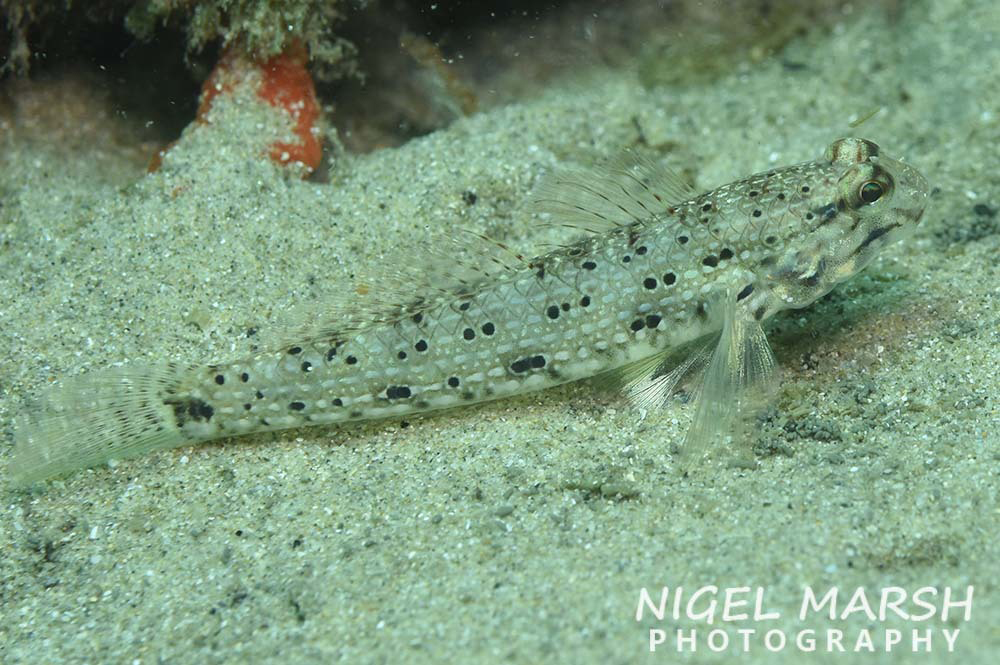Reticulate Sandgoby, Istigobius spence (Smith 1947)
Other Names: Pearl Goby, Reticulated Goby, Twin-spots Sand-goby

A Reticulate Sandgoby, Istigobius spence, on the Gold Coast, Queensland, July 2019. Source: Nigel Marsh / iNaturalist.org. License: CC by Attribution-NonCommercial
Summary:
A pale sandgoby with rows of pale-edged dark spots and white spots or dashes along the body, a dusky line from the eye to the pectoral fin base, and wavy brown lines on the snout. Males have darker pelvic fins and the outer part of the anal fin darker than females. Some males also have 3-4 vertical bars on the abdomen and 2-3 horizontal bars along the first dorsal fin.
Cite this page as:
Bray, D.J. 2022, Istigobius spence in Fishes of Australia, accessed 08 May 2024, https://fishesofaustralia.net.au/home/species/3061
Reticulate Sandgoby, Istigobius spence (Smith 1947)
More Info
|
Distribution |
Monge Island, Kimberley region, Western Australia, to the Solitary Islands, New South Wales. Elsewhere the species is widespread in the Indo-west-central Pacific, from the Red Sea and east Africa eastwards through the East Indian region to Papua New Guinea, Australia (Northern Territory and Great Barrier Reef), New Caledonia, Palau and Federated States of Micronesia. east Africa to Australia. Inhabits sandy and rubble areas on coastal and nearshore silty reefs, including turbid coastal areas near river mouths in depths to 12 m. |
|
Features |
Dorsal fin VI + I, 10-11; Anal fin I, 9-10; Longitudinal scale series 30-32; Predorsal scales (cycloid) 7-10; Vertebrae 26. Body depth 4.9-6.1 in SL; appressed anal fin reaching within a distance of 1-2 scales of caudal fin in male, 2-4 scales in female; appressed 2nd dorsal slightly overlapping caudal in male; pectoral-fin rays entire. Predorsal scales cycloid, scales absent from cheek and opercle, trunk scales ctenoid. Genital papilla of male reaching anal spine. Female genital papilla truncate, ending well before origin of anal fin. |
|
Colour |
Few spots on nape; a dusky line running from eye dorsal to sensory pore path, ending at or before pectoral fin base; wavy brown lines on the snout. Pelvic and distal part of anal fins darker in males than in females. Some males with 3-4 vertical bars on abdomen and 2-3 horizontal bars in first dorsal fin. |
|
Etymology |
The species is named in honour of Charles Spence, who assisted J.L.B. Smith in Mozambique. |
|
Species Citation |
Gobius spence Smith, Annals and Magazine of Natural History 11 13(77): 809. Type locality: Delagoa Bay, Mozambique. |
|
Author |
Bray, D.J. 2022 |
|
Resources |
Reticulate Sandgoby, Istigobius spence (Smith 1947)
References
Allen, G.R. & Erdmann, M.V. 2012. Reef fishes of the East Indies. Perth : Tropical Reef Research 3 vols, 1260 pp.
Hoese, D.F. 1986. Family No. 240: Gobiidae. pp. 774-807 figs in Smith, M.M. & Heemstra, P.C. (eds). Smith's Sea Fishes. Johannesburg : Macmillan South Africa xx + 1047 pp. 144 pls.
Hoese, D.F. & Erdmann, M.V. 2018. Description of a new species of Istigobius (Teleostei: Gobiidae) from Australia and Indonesia. Journal of the Ocean Science Foundation 30: 70–77. http://dx.doi.org/10.5281/zenodo.1291469
Hoese, D.F. & Winterbottom, R. 1979. A new species of Lioteres (Pisces, Gobiidae) from Kwazulu, with a revised checklist of South African gobies and comments on the generic relationships and endemism of western Indian Ocean gobioids. Royal Ontario Museum, Life Sciences Occasional Paper 31: 1-13
Kuiter R.H. & Tonozuka, T. 2001. Pictorial guide to Indonesian reef fishes. Part 3. Jawfishes - Sunfishes, Opistognathidae - Molidae. Melbourne : Zoonetics pp. 623–893.
Larson, H. 2016. Istigobius spence. The IUCN Red List of Threatened Species 2016: e.T193256A2215070. http://dx.doi.org/10.2305/IUCN.UK.2016-3.RLTS.T193256A2215070.en. Downloaded on 19 June 2018.
Larson, H.K., Williams, R.S. & Hammer, M.P. 2013. An annotated checklist of the fishes of the Northern Territory, Australia. Zootaxa 3696(1): 1-293
Moore, G.I., Morrison, S.M., Hutchins, B.J., Allen, G.R. & Sampey, A. 2014. Kimberley marine biota. Historical data: fishes. Records of the Western Australian Museum, Supplement 84: 161-206
Murdy, E.O. & Hoese, D.F. 1985. A revision of the gobioid fish genus Istigobius. Indo-Pacific Fishes 4: 1-41 figs 1-8 pls 1-3
Myers, R.F. 1989. Micronesian Reef Fishes. Guam : Coral Graphics 298 pp.
Smith, J.L.B. 1947. New species and new records of fishes from South Africa. Annals and Magazine of Natural History 11 13(77): 793-821
Smith, J.L.B. 1959. Gobioid fishes of the families Gobiidae, Periophthalmidae, Trypauchenidae, Taenioididae and Kraemeriidae of the western Indian Ocean. Ichthyological Bulletin of the J.L.B. Smith Institute, Grahamstown 13: 185-225 figs 1-42 pls 9-13 (as Acentrogobius spence) http://hdl.handle.net/10962/d1018774




